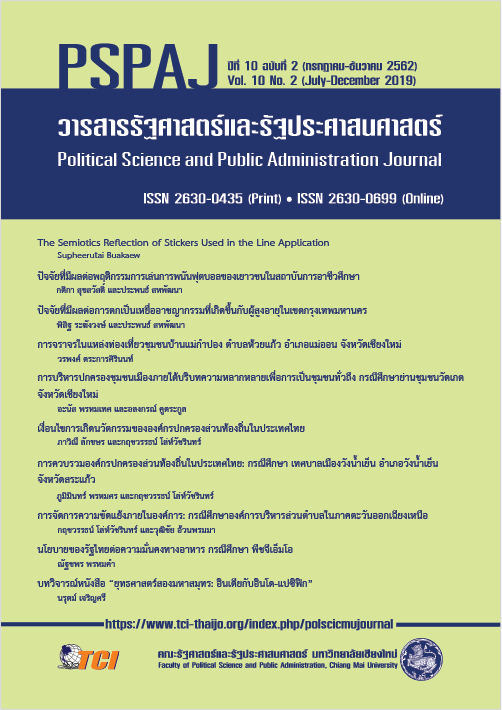The Semiotics Reflection of Stickers Used in the Line Application
Main Article Content
Abstract
This research aims to understand the function of stickers, as signs, used in the Line application and explore the semiotic reflection of stickers -the relationship and closeness level, between the senders and receivers. This is a mix of quantitative research and qualitative research. In the quantitative part, 152 screenshots of personal chats were collected from twenty-five university students. They were asked to categorize their relationships with their interlocutors into 5 groups; Lover, Immediate Family, Extended Family, Professional Relationship and Friend and rate the relationship closeness level. The statistical package program - Pearson Correlation method is used to explore the correlation between the relationship closeness and the number of stickers used in the chats. Though the correlation result is weak (r = 0.312, p < 0.05) but the positive linear relationship suggests a significant correlation between relationship closeness and the number of stickers used in the Line application (Sig 0.027, Sig < 0.05). In the qualitative part, the triadic model of the sign is applied to understand the function of stickers as sign, used in the Line app. It is found that stickers were interpreted according to the perception of the relationship among the Representamen, the Object and the Interpretant. Likewise, to Emojis, stickers also have the ability to construct and substitute messages. Plus, stickers illustrate actions and facial expressions that are lacked in Emojis. The curtain stickers are employed specifically with curtain interlocutors. The use of stickers in the chats reflects and conveys both direct meaning of stickers and semiotics meaning-relationship and level of closeness between senders and receivers.
Article Details
- เนื้อหาและข้อมูลที่ลงตีพิมพ์ในวารสารรัฐศาสตร์และรัฐประศาสนศาสตร์ถือเป็นข้อคิดเห็นและความรับผิดชอบของผู้เขียนบทความโดยตรง ซึ่งกองบรรณาธิการวารสารรัฐศาสตร์และรัฐประศาสนศาสตร์ ไม่จำเป็นต้องเห็นด้วย หรือร่วมรับผิดชอบใดๆ
- บทความและข้อมูล ที่ได้รับการตีพิมพ์ในวารสารรัฐศาสตร์และรัฐประศาสนศาสตร์ ถือเป็นลิขสิทธิ์ของวารสาร หากบุคคลหรือหน่วยงานใดต้องการนำข้อมูลไปใช้ประโยชน์ในทางวิชาการ ขอให้อ้างอิงแหล่งที่มาด้วย
References
LINE STORE. (n.d.). Official Stickers. Retrieved September 3, 2017, from https://store.line.me/stickershop/home/general/th
Barnes, S. (2002). Computer-mediated Communication. Boston, MA: Allyn and Bacon.
Chandler, D. (n.d.). Semiotic and Semiology. Retrieved March 10, 2017, from https://map.sdsu.edu/geog581/week-08.htm
Chislett, D. (2019). What are the Oldest Languages on Earth?. Retrieved October 25, 2018, from https://taleninstituut.nl/en/what-are-the-oldest-languages-on-earth/
Danesi, M. (2017). The semiotics of Emoji. London: Bloomsbury.
Derks, D., Bos, A., & Grumbkow, J. V. (2007). Emoticons and Online Message Interpretation. Social Science Computer Review, 26(3), 379-388. doi: 10.1177/0894439307311611
Hinkle, D., Wiersma, W., & Jurs, S. (1998). Basic Behavioral Statistics. Illinois: Rand McNally College.
iEmoji. (2018). Lookup, Convert, and Get Emoji!. Retrieved May 15, 2017, from https://www.iemoji.com/
Nöth, W. (1990). Handbook of Semiotics. Bloomington: Indiana University Press.


